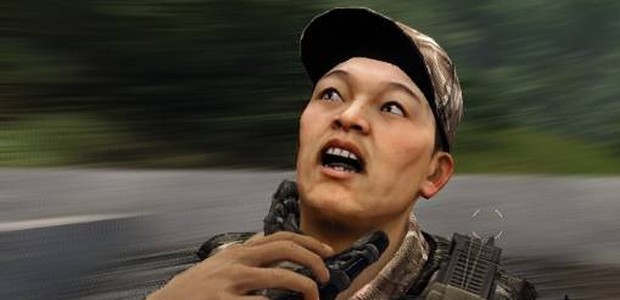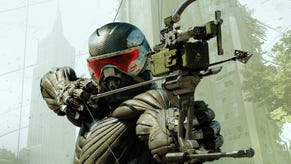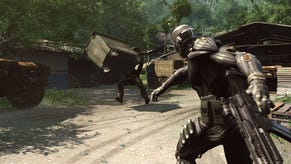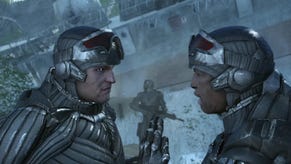Campaign For A Better Memory Of Crysis 1
Maximum Nostalgia
There's an open stretch of grass between me and the thin exterior wall of a small island village. The place is crawling with enemy troops, who move along the dirt roads and populate the ramshackle buildings in groups of two or three. Defensive turrets would already be firing at me if I my nanosuit wasn't keeping me invisible, the energy bar barely moving for as long as I remain still.
So I start to run.
You want Advanced Warfare? Crysis did that seven years ago.
Ten feet, twenty feet. As I'm about to reach the wall, I hold middle mouse button and with a flick of the wrist transition into Strength mode. In the same second I turn visible, I hit jump, and use the suit's ability to propel myself up and over the wall. I'm cloaked again before I hit the ground on the other side.
In the seven years since the original Crysis, there have been a lot of games with empowering movement systems. Just Cause's grapple; Prototypes sprinting up skyscrapers; Saints Row's faster-than-cars sprint; Dishonored's blink; Human Revolutions weird glow-ball slow descent thing. I don't think I enjoy any of them as much as I do the nanosuit in Crysis 1. It turns every part of that game's environment into a puzzle.
There's always some sense of this. In Dishonored, if you want to move from one area to another, you need to predict how far the blink ability will get you before you run out of the magic juice that powers it. That's a more serious challenge on harder difficulty levels, but it's still ultimately a simple piece of mental arithmetic. Blink here, then there, then wait, then continue.
Crysis is slightly more involved to think about, because each distinct action on your route requires a different suit mode. There's no single movement ability that will get you cleanly from A to B, when A is on a beach and B is on top of a building surrounded by enemy soliders and tanks.
It's also slightly more involved to perform, because there's no single button to press or hold to perform each action. If you want to move stealthily, you'll need to minimise your time spent outside of Cloak mode, which means timing jumps, sprints and other mode-shifts perfectly. Or if you're in a dangerous area with no choice but to confront the soldiers or aliens, you'll want to find ways to maximise your time spent in Armor mode.
Stringing together these movements in quick succession feels as good as performing perfect parkour in Mirror's Edge. The difference here is that your supers-suit doesn't only enable mobility. In Crysis, you're a tank who can perform parkour.
I move between two buildings, Strength mode, jump onto the roof of one of them, Cloak mode again. I'm in the outskirts of the village now and I can hear chatter of some soldiers in the building I'm now straddling.
The suit's powers aren't just bad news for the Korean soldiers who are exploring this remote island, it's bad news for those ramshackle buildings, too. If you leap upon the roof of a garage built of tin sheets and you want to get inside, you can switch to Strength mode and punch your way in. This isn't a pre-determined breakable chunk of roof, either; most buildings in most villages through most of the early stages of the game are made from nailed together sheets of metal, and you can punch your way through almost any of them. Destroy the structure of a building too fully and the whole thing will collapse, crumbling into a set of physics objects.
You can't do that in Far Cry 2 or 3. You can't even do that in Crysis 2 or 3. Apparently getting the AI to adapt to this shifting terrain was the hardest challenge developers Crytek faced in the creation of the original Crysis, but having solved the problem, they decided never to use the solution again. I can't understand why. The Koreans are dolts and a joy to manipulate and overpower, but are smart about what's cover and what's not, what's passable and what's not, and are good at flushing you out of hidey-holes with grenades or flanking. They're an interesting enemy to fight and Crytek created an interesting environment to fight them in.
I don't punch my way inside in this instance. Instead I spot a soldier on his own, outside. I drop down in front of him, still cloaked, and grab him by the throat. His face shows highly detailed terror; eyes wide, mouth hanging open. I switch to Strength mode and toss him away like a ragdoll.
On its release, Crytek bragged a lot about how good Crysis 1 looked. The consoles can't run this, they said. Neither could most PCs. Today it'll run smoothly on any even slightly modern machine, but time hasn't dulled its good looks. It never had the bizarre, postcard brightness of the original Far Cry. It slopes far closer to realism, and there's consequently something muted and muddy about a lot of its colours. But what it lacks in sunny disposition it makes up for with sheer scale.
I've always thought Crysis was unfairly maligned for the back half of the game. Yes, the aliens aren't as fun to fight as the Koreans. Yes, there is an escort mission in which your charge dies of cold if not standing in a bonfire every twenty seconds. It's not what anyone really wanted from the game.
But it's also got an enormous tank push across a jungle valley while a mountain cracks open in the distance to reveal a buried spaceship. It's got zero gravity exploration inside that spaceship which, if unfortunately marked by guff combat, is at least fittingly strange and alien. It's got the visual spectacle of half the tropical island being suddenly frozen by those aliens, re-painting previously visited locations with ice and snow. It's got a distant nuclear explosion as viewed from a fleet of military ships which rock from the waves caused by the blast. It's got an uncommonly large alien mothership in the midst of an ocean storm.
It's got that little LCD screen ripple when a character presses their finger against a computer monitor.
Crysis turns into a dumb action movie before the end of its running time, but at least that dumb action movie has the decency to be an inventive, memorable spectacle.
It seems a shame that the more disappointing sequels should doom the original Crysis to be remembered solely for its mediocre back half, when I think it's opening chapters are great, still worth playing, and offer joys which few games compete with.
At this point I realise I don't remember what my mission is in this village. I've completed it before, so it hardly matters. I sneak around the dusty outskirts, tagging distant enemies and silently dispatching any I meet. When I reach the camp's west edge however, I notice that we're still alongside the sea. There are white sands stretching down to the ocean and I spot some crabs skittering around.
"Maximum Strength," my suit chirps. And off I run.












